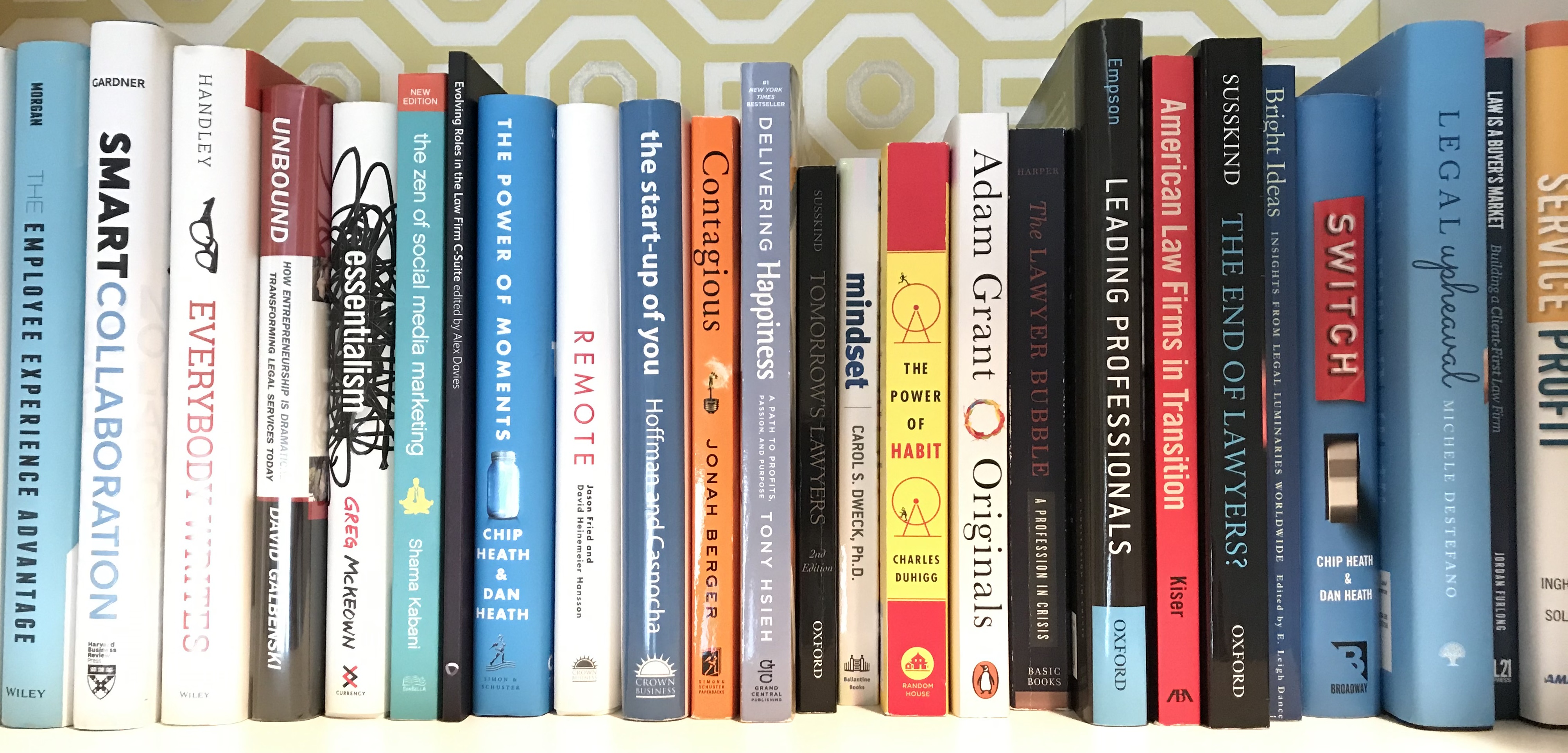I have been doing a lot of reading lately on the need for law firms to refocus their strategy on the client. This refocus includes everything from better understanding the client and the client’s business to providing an exceptional client experience. For those who are as interested in this subject as me[i], here are some of the books I have found most valuable along with some small lessons from each.
Why do law firms need to refocus on the client?
In short, because clients are asking for it, and they are going to start asking more loudly. And you can’t increase revenue without clients.
American Law Firms in Transition: Trends, Threats and Strategies by Randall Kiser is an incredible primer on many hot topics in the legal industry.[ii] It includes this summary of an ALM Legal Intelligence survey of law firm leaders: “’Growing the firm’s revenue’ is the highest priority for law firms. But only 56 percent of firms have a ‘plan in place to build, track and measure client loyalty and satisfaction.’ Only 21 percent of leaders would like to ‘provide higher service levels,’ and only 9 percent would like to ‘institute client satisfaction surveys/interviews.’ Increasing revenue without tracking and improving client service strikes most people in business as incongruous, if not impossible.”
This means that law firms are relying on raising rates and billing more hours as their primary means of increasing revenue – probably not a sustainable long term strategy.
Another of my favorite Kiser observations is this: “Although attorneys try to impress new clients with their competence, clients are seeking answers to three threshold questions: Can I trust you? Do you care about me? Are you committed to my success?” As a former lawyer, upon reading this, I realized that I often default to trying to prove my competence as a qualified expert in an initial client meeting, rather than focusing on building trust and warmth.
If we want to increase revenue, it seems logical to start with providing the buyer of our services with the exact service they want and need. This has to be part of a law firm’s strategy. How can we increase revenue if we are too busy proving our competence and never stop to ask clients what they are looking for?
In Legal Upheaval: A Guide to Creativity, Collaboration, and Innovation in Law, Michele Destefano elaborates on this point, stating that the value provided to outside counsel when law firms spend time “problem finding” versus “problem solving” is significant.
Destefano quotes the GC of a global cybersecurity company speaking about her outside counsel: “They want to have a one hour kickoff call but really just want to suck off info from you and they are sort of listening to you but also selling themselves and it’s an hour and a half and they bill you for it and you could have found it on my website and then asked five minutes of targeted questions and that would have showed your value.” Preach. It is hard to overstate the value of doing your homework.[iii]
[Note: while worth reading, Legal Upheaval doesn’t make my “ohmygosh, you have to read this” list.]
How can we make this shift happen?
Build trust within your firm and realize that takes time. No one is going to listen to advice from someone they don’t trust.
Law is a Buyer’s Market: Building a Client-First Law Firm by Jordan Furlong is an incredibly thorough study on how to shift your firm’s focus to one that is more client-centric.[iv] Furlong acknowledges throughout the book that making this change is hard and offers this advice on the best approach: “Veteran salespeople talk about the “rule of seven touches” – it requires seven personal interactions to establish a level of trust sufficient for someone to take up a suggested course of action… Facilitating change in an organization is not that different.”
Don’t make it about you or take credit.
In Leading Professionals: Power, Politics and Prima Donnas by Laura Empson, Empson discusses at length the ideal people to lead law firms.[v] One observation specifically really resonated with me: “it takes a special kind of person to succeed as a management professional within such organizations. They need to be exceptionally good at the job but also willing to stay out of the limelight.”
And make the shift easy.
I read a whole book on this called Switch: How to Change Things When Change is Hard by Chip Heath and Dan Heath. In it, the authors state “If you want people to change, you can provide clear direction… or boost their motivation and determination… Alternatively, you can simply make the journey easier. Create a steep downhill slope and give them a push. Remove some friction from the trail. Scatter around lots of signs to tell them they’re getting close. In short, you can shape the Path.”
The Heath brothers’ lesson? If you want to help your firm make a change, make it as easy as possible. For example, if you want your real estate associates (and even some partners) to better understand the economics of real estate deals so they can better understand their clients’ motivations, create a lunch seminar on the topic and secure CLE credit for the time. Feed them; provide them CLE time; and don’t take them away from their desks for more than hour. Win. Win. Win.
Before you tell me, “easier said than done,” I have done exactly this. It’s not that hard. (And if you would like me to teach your associates this commercial real estate economics lesson, send me an email.)
What are some concrete examples of what the shift to knowing your client better and exceptional client experience looks like?
Remember: the little things add up.
It seems obvious to start this topic with a book named Exceptional Service, Exceptional Profit: The Secrets of Building a Five-Star Customer Service Organization by Leonardo Inghilleri and Micah Solomon. However, to be honest, I probably would not have heard of this book if I had not attended a Law Firm COO/CFO Summit moderated by Inghilleri a few years ago. Inghilleri’s insights were incredibly eye-opening and I was anxious to read more of them.
In Exceptional Service, Inghilleri and Solomon discuss the collective effect of small client-focused touches. (p.72) They warn that while a firm might believe that something like a follow-up thank you note is not valuable to the client, getting rid of it can have unforeseen ramifications. “All of these touch points, and so many more, ultimately build an experience that is more than the sum of its parts: The collective is what does it. That’s why the attention to details is so important in the service business: making sure that each one of those touch points is well executed.” He adds “service-focused companies tend to delete crucial value from their service offerings, all in the name of efficiency.”
The Power of Moments by Chip Heath and Dan Heath, echoes this sentiment with the statement: “Beware the soul sucking force of reasonableness.” For instance, while it is easier and arguably accomplishes the same purposes, an emailed Thank You does not make the same impact as one that is handwritten and mailed. Reasonably, email saves time. But it’s a compromise. Don’t compromise.
Over deliver.
Another Inghilleri gem: “Don’t imagine you’re doing something special for a customer by making things how they should have been in the first place.” (p.35) In context, Inghilleri is referring to compensating a customer for a service failure. However, I believe it applies to all service delivery. If you deliver only what is expected, you are not creating a client for life.
Don’t pass up an opportunity to know what your client is thinking.
The End of Lawyers: Rethinking the Nature of Legal Services by Richard Susskind is a must-read classic for those interested in the legal industry. Among all of the big ideas, I found this little gem: “Most lawyers with whom I speak dismiss Twitter as yet another plaything for their children. Of what possible relevance, they inquire, could this possible be for a senior legal practitioner? I reply that I know quite a few General Counsel and senior in-house lawyers who now use Twitter and regularly send out messages about what they are doing, what they are thinking, and where they are going: and if my clients were sending out regular updates on their news and views, I would want to be on the receiving end, even if the medium has a slightly silly name.”
On a related note, I suggest searching for your client’s individual and company names on the Podcast app. If they are speaking on a podcast, you should probably listen to what they have to say.
In the next installment of “what Anita is reading,” I will share some articles I think may be worth your time.
Until then…
[i] I realize I just lost 90% of my readers with this statement.
[ii] Send me an email if you would like a copy of my extensive notes on this book.
[iii] I preach this to my kids on the daily and it is yet to be determined whether the message is sinking in.
[iv] I highlighted half the book as I found so much of it worth future reference.
[v] A must-read if you are a managing partner or COO/Executive Director.

